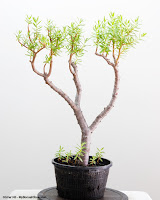An early one was my best trident maple, which gave me a bit of a scare back in 2009 but worked out well in the end. It was a five foot nursery tree when I bought it and, having a long drive in front of me, I asked the nursery staff to reduce the height so that it could fit into the car.
 |
| At the nursery, as purchased |
This was how it left the nursery:
 |
| Autumn 2009, before workshop |
I was still pretty new to bonsai at the time and wasn't sure how to proceed so I contacted my mentor who told me to bring it to a workshop. Although it was autumn, he repotted it and cut it back to a more appropriate height - or so we thought.
 |
| Autumn 2009, after workshop |
Despite repeated efforts to seal the wound, it oozed sap for about two weeks, which was probably the cause of its problems in early spring. New growth was slow to appear and for a while I really feared for its life. And when new branches finally sprouted, they appeared about half way down the trunk:
 |
| Summer 2009 |
I had no choice but to cut the tree back to where there was new growth:
 |
| Summer 2009. after the second chop |
With the benefit of hindsight the original chop would probably have left me with a tree that was far too tall and thin, so everything worked out for the best in the end. I'm quite happy with the tree's current state, apart from the nebari, but I'm working on that.
My most recent attempt at a trunk chop, done unassisted, involved two little elms I bought in late 2015. When I bought them they were growing together in one pot:
 |
| Two little elms as purchased, November 2015 |
Aside from feeling that they didn't belong together, I also felt they were too tall and straight, so I separated them and chopped both back to stumps.
 |
| After the chop, November 2015 |
Clearly this time I did everything right because they soon sprouted from their chop sites.
I've done very little work on them since then, only removing branches that I knew I'd never use and doing a little wiring where necessary.
This is how they look now:
 |
| Larger tree, December 2017 |
 |
| Smaller tree, December 2017 |
Right now I'm waiting for the leaders to thicken up a bit. Once that happens I'll reduce their height and start developing more branches. Hopefully in a couple of years from now I'll have the beginnings of two nice little trees.











































